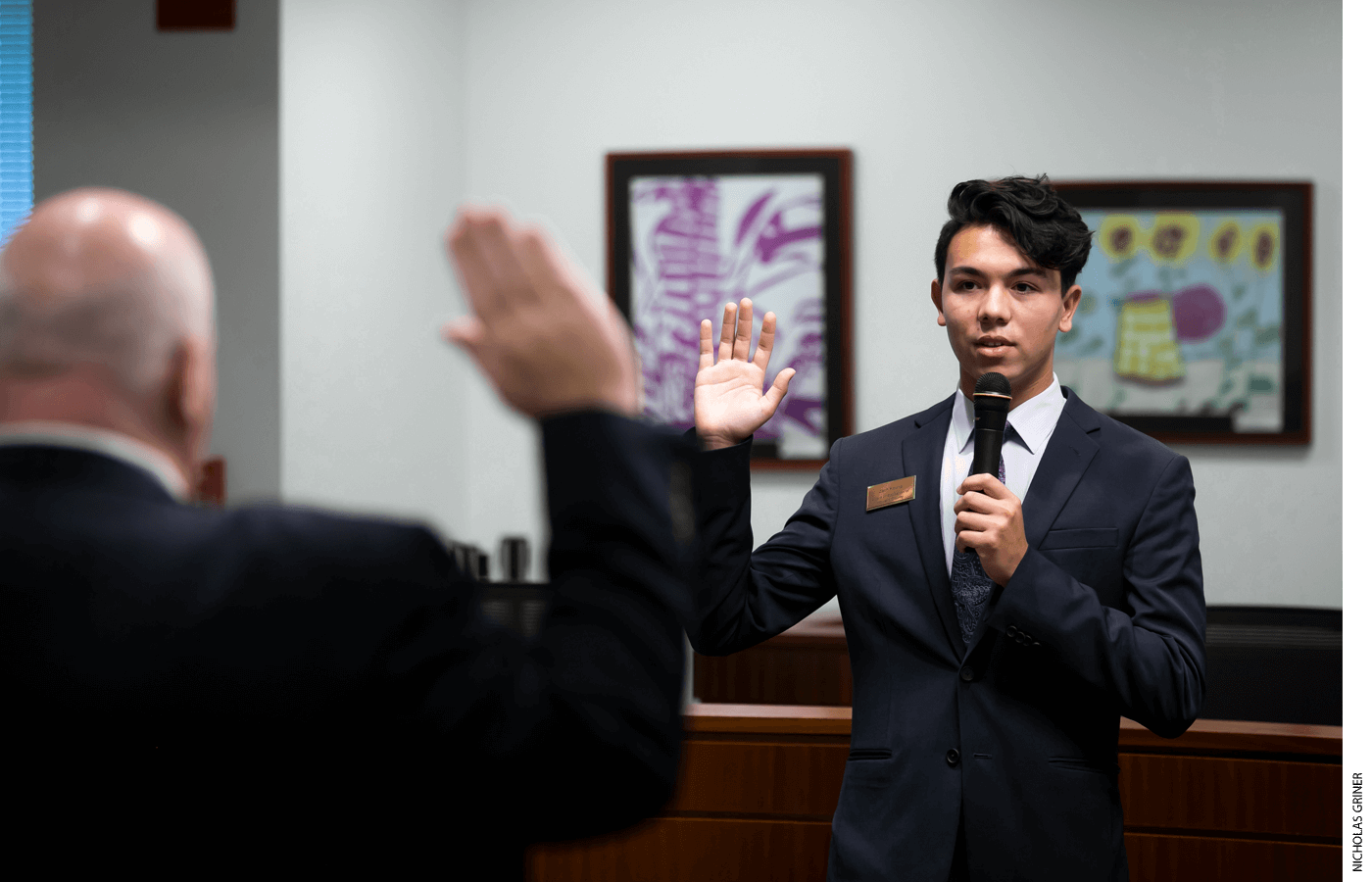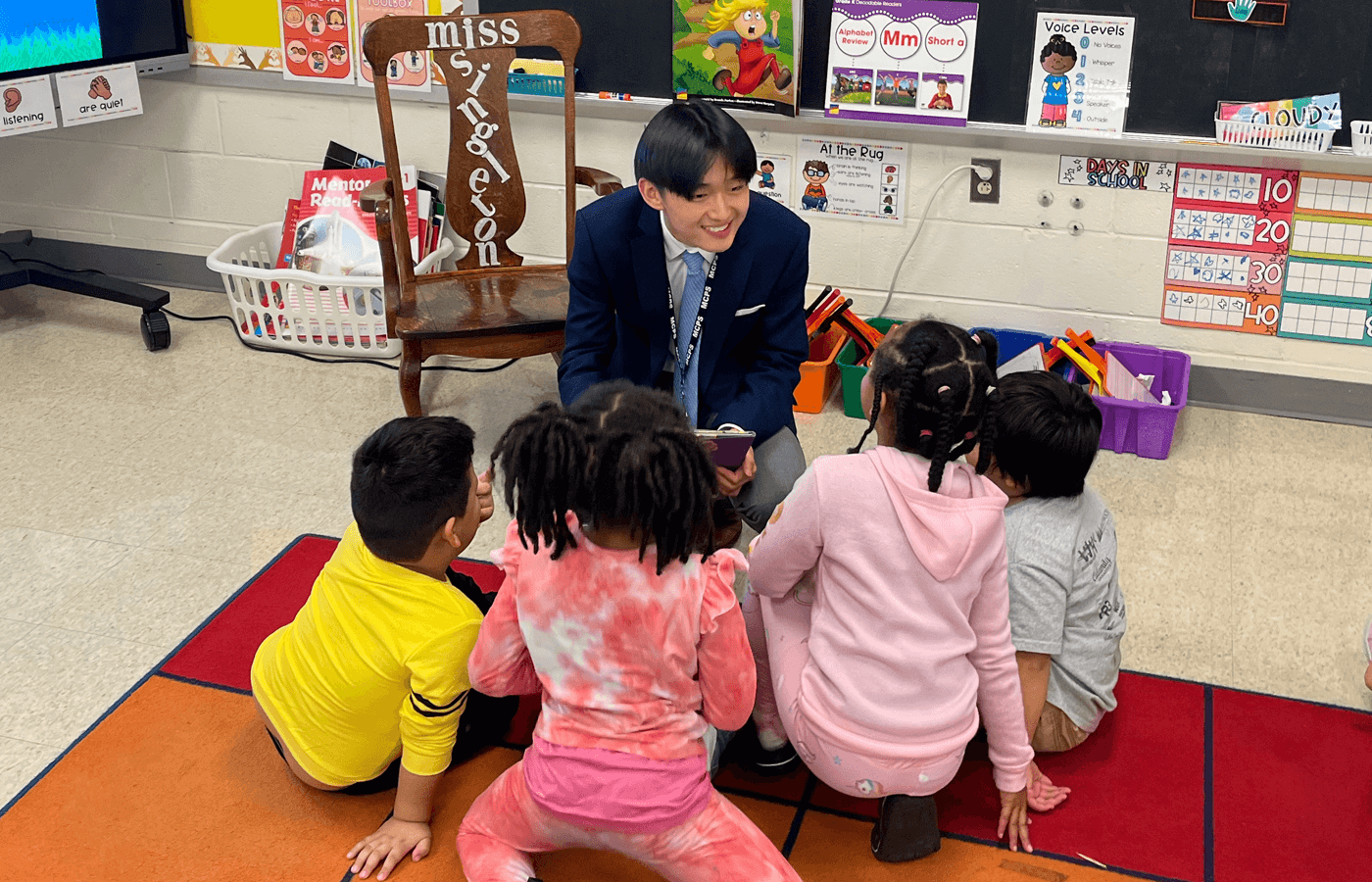
University of Pennsylvania undergrad Zach Koung remembers the moment during a college class when his past caught up with him. “We were talking about school boards, and one of my classmates said, ‘Wait, Zach, weren’t you on a school board?’”
Yes, Koung said. Not only did he serve on his local board of education during his senior year of high school but he also wound up at the center of two lawsuits challenging his power to cast binding votes. “I never thought that at 17 I’d rack up the creds for that,” he joked.
Koung, the 2020–21 student member of Maryland’s Howard County Board of Education, can make light of his experience now, but it didn’t feel funny at the time. Furious parents so aggressively protested his votes to maintain remote-only learning during the COVID-19 pandemic that he sought counseling and feared for his safety. “I literally did not leave my house because I was afraid,” he said.
In August 2022, the Howard County board prevailed when Maryland’s highest court upheld the constitutionality of allowing students under 18 to serve as voting members. In November, a separate federal lawsuit against the board was dismissed. With the court challenges over, Koung was free to speak out about giving students a direct say in the policy decisions that govern their public schools.
“Students are the most important stakeholders in their education,” said Koung, who is simultaneously pursuing a bachelor’s degree and a master’s degree in education policy at Penn. “This is building civic engagement and helping prepare students for the world that awaits them once they leave school.”
In this belief, Koung is not alone. School boards are being pushed to give students a seat at the table—and a vote when they get there—perhaps harder than at any time since the wave of student activism in the late 1960s and 1970s.
To be sure, student school-board members who wield a binding vote are not the norm, and court fights like those in Maryland remain rare. Still, the emergence of a startup national association of student board members—in concert with organizing and policy action at the state and local levels—suggests that if the issue has yet to reach your community, it may be coming to a school board near you.
“There is growing momentum around the issue,” said Andrew Brennen, who is board chair of the Kentucky Student Voice Team. Brennen tracks developments on student board members for the newsletter “From Student Voice to Student Power.”

Varying Degrees of Authority
The roles of student board representatives vary widely by location, with little uniformity even within individual states. Some students sit on state boards, others on local ones. Some have binding votes, while others can’t even sit on the dais with regular board members. Some are appointed by state or local officials after vetting by student government associations, while others are chosen in broad elections open to the full student body starting as early as the 6th or 7th grade.
Amid calls to elevate student voice in policymaking, how student board members are selected is just one in an array of questions being pressed by educators, policymakers, and most notably, students themselves. These players are examining not only the threshold question of whether K–12 students should be involved in education governance, but also which powers they should hold in such roles.
Besides voting rights, for example, should they have access to board sessions that are closed to the public? How should they be trained and supported? And what recourse, if any, should adult voters have to hold student representatives accountable for decisions that may affect families’ lives, students’ trajectories, and taxpayers’ pocketbooks?
As causes go, student school-board representation draws far less attention than issues animating young activists such as climate change, gun violence, racial equity, or LGBTQ rights. Moreover, students face formidable barriers to expanding their participation on school boards and to exerting significant policy impact once there.
Those obstacles range from the brief and transitory nature of student leadership roles to skepticism and sometimes vigorous opposition from adults. In Kentucky, for example, state lawmakers in 2021 nearly succeeded in abolishing the seat of a nonvoting student member of the state board just months after the first one took office.
Yet supporters see this comparatively low-profile school governance issue as a means for students to influence a range of other causes that matter to their generation. And they point to examples of recent legislative and policy wins—such as helping lead efforts in California to give students excused mental-health days and fighting for free menstrual products in Maryland—as evidence that the student role can extend beyond tokenism.
“Young people are becoming more and more active in the issues of the day, in particular the issues that directly affect them—where education needs to go, how learning needs to happen in our country,” said Vicki Phillips, chief executive officer of the National Center on Education and the Economy, a Washington-based think tank that is incubating a national association of student board members.
The students organizing the national association are “incredibly thoughtful, well-researched, strategic young people,” said Phillips, who is also a former chief state school officer in Pennsylvania and superintendent of schools in Portland, Oregon, and supported student-voice efforts in prior positions at the Bill & Melinda Gates Foundation and National Geographic. “Their orientation is about how to serve everybody well, and they need a seat at the table.”
Not everyone agrees. And nothing concerns skeptics more than empowering students to cast binding votes. “The largest stakeholders in the prison system are people behind bars, and I don’t think they get many votes on what to have for lunch,” said Reid Novotny, who authored unsuccessful legislation in 2021 and 2022 as a GOP member of the Maryland House of Delegates to curtail student board members’ voting rights. “There is zero accountability with a student member of the board to anyone who is a functioning adult paying taxes.”
Novotny’s views align with his former constituent Traci Spiegel, a plaintiff in the state suit against Maryland’s Howard County school board challenging the practice of allowing student members like Zach Koung to cast binding votes. Filed in December 2020, the suit came after Spiegel and like-minded parents watched in mounting frustration as the board deadlocked 4–4 in votes to allow a return to in-person classes. Permitted under state law to vote on a limited number of issues, Koung was among the four who repeatedly voted to remain virtual.
“I’ve never been against students having a voice in decisions,” Spiegel said. “I just don’t think they should have a binding vote. When you’re 17, you are incredibly idealistic. You don’t pay taxes, you would choose to eat pizza every night for dinner, you would drive your friends around at 3 a.m. How in the world can you make the same decisions as adult members?”
Asking students to vote on such issues as whether to cancel exams during the pandemic puts too much pressure on them, argued Spiegel, who said she’s been inaccurately “painted as a racist, homophobic, extreme right-wing person” because of her stance. “The adults in the room should be ashamed to be putting a young person in that position.”
Even some supporters of student board representation harbor qualms. Maryland state Senator Nancy King, a Democrat, recalls that when she was serving on her local school board, opponents of proposed changes to school-attendance boundaries directed their ire at the student member in person, in hostile phone calls, and on social media. “They would think that the student board member was an easy target,” she said. Pressure can come from inside the classroom, too, King added. “Teachers might not like a contract issue, and the teachers take it out on the kid. It doesn’t happen often, but it does happen.”
Yet King has largely overcome her concerns. “I started out as a real nonbeliever on the student members having a vote. But then I saw many student board members being really well prepared, and in fact better-prepared than some of the adult members,” King said. “So I have gone along with it, but it’s not without some trepidation. I just think it’s a lot of responsibility to heap on the kid.”

Differences among States
Nationally, data on how many American school boards include student members is scarce. Those who follow the issue say no national database tracks that information. Research on student board members in the United States is also scanty, said Dana Mitra, a Pennsylvania State University education professor whose research focuses on student voice: “It’s really hard to study it in the United States, because it’s more of an anomaly than a part of how schools should be running.”
In 2022, the National Association of State Boards of Education found that 24 state-level boards of education had student members, although 17 of them did not allow students to vote. In the District of Columbia and six states—California, Maryland, Massachusetts, Tennessee, Vermont, and Washington—the student board members held the power to vote on at least some issues, NASBE found.
In some states, students’ powers have evolved. In California, for example, the state board has had student members since 1969, but not until 1983 did they get full voting rights and the right to be in closed sessions.
As for local boards, the National School Boards Association found in a 2020 survey of state-level affiliates that local governing boards in more than 30 states had student members as a local option. The NSBA report did not yield clear data on all states, however. And since its report in January 2021, at least one state changed its law; New Hampshire now requires local school boards to have at least one nonvoting student representative from each of their public high schools.
Fourteen states reported to the NSBA that “having students serving on local school boards was not their practice”—Alabama, Arkansas, Georgia, Idaho, Indiana, Kansas, Louisiana, Mississippi, Missouri, New Mexico, North Dakota, Oklahoma, South Carolina, and Texas.
Nationally, Maryland stands out for empowering student board members. Only eight of the state’s 24 local districts have student board members with the right to cast votes that count, at least on some issues, but those eight districts educate more than three-quarters of Maryland’s public school students.
Maryland’s Anne Arundel County, which includes the state capital of Annapolis, is believed to be the nation’s only local school board that grants its student members full, unrestricted voting rights on all matters—from the school system’s budget and union contracts to hiring and firing the superintendent. “Our student member gets treated differently from student board members” elsewhere, said board president Joanna Bache Tobin. “There’s never a moment when that student member has to leave the room when the board has to make the tough decisions.”
During a more than four-hour public meeting of the Anne Arundel board in December 2022, student member Zachary McGrath limited his comments to joking about a local high-school football team and thanking Tobin and the board’s vice president for being “mentors and friends.”
He offered no remarks during the meeting’s most contentious deliberations, on whether the 2023–24 school calendar should be adjusted to send students home early to accommodate equity-focused professional development for teachers. As board members divided 6–2 in a series of four votes, McGrath always sided with the majority without explaining his vote or participating in the discussions.
But McGrath and other board members said his influence is not always on public display. “I speak up a lot during the closed session, but then in the public session, I only speak when I feel like I am adding something to the conversation,” he said. One example came as the board was considering a new online learning platform, and “the superintendent asked me, ‘What is the student perspective?’” McGrath recalled. He replied that the platform with the better app would let students with long bus rides get their homework done en route. “When I said that, Dr. Tobin said, ‘Ladies and gentlemen, that’s why we have a student member of the board.’”
In California, districts must appoint a student school-board member if enough of those enrolled in their high schools sign petitions requesting it. Student members each have a “preferential vote,” defined as “a formal expression of opinion that is recorded in the minutes and cast before the official vote of the board, but is not part of the final vote tally.”
In 2021, a new law extended California students’ power to petition for board membership from local districts to county and charter school boards. That change marked a win for an association of student board members founded by Zachary Patterson, a Duke University undergraduate who served as the first student member of the San Diego Unified school board before graduating in 2022. Patterson is now helping organize the national association being incubated at the National Center on Education and the Economy.

Student Voice
Patterson hopes the national organization will help counter what he sees as disrespect of students’ capability to serve as board members. “We’re at our early stages of figuring out this inherent adultism and addressing the barriers people have put in place to exercising student agency,” he said.
Patterson’s interest in student voice began when he was in 7th grade and saw “a disconnect between those serving students and the students. That put me on a three-year journey to create a student board member.” Patterson said he “received significant pushback from a number of quarters, a strong belief that students weren’t qualified, they couldn’t handle it, and they weren’t able to be advocates to help change their own school system.” But in 2019, during his sophomore year, the campaign paid off when he was sworn in as the district’s first student board member.
Like Patterson, many current student board members argue that policymakers make better decisions when students have a say. “Who knows more than our students about how these issues are really affecting our learning in the classroom, what the classrooms and the hallways of our school buildings even look like?” asked Arvin Kim, the 2022–23 student member of the school board in Montgomery County, Maryland.
That firsthand knowledge can be especially important amid culture-war conflicts on school boards over how to treat race, sexuality, and student discipline, supporters argue. Among them is Eric Luedtke, a former teacher and Democratic state legislator who is now chief legislative affairs officer for Maryland Governor Wes Moore. “To the extent that the culture war debates are about what students should be exposed to, shouldn’t students have a voice in that discussion?” he asked.
Student board members tend to boast impressive resumés—and head to top colleges after graduation. While such exceptional students may help assuage doubts about student board members’ maturity and judgment, some see the pattern as a problem.
“We have no student-voice movement unless we have every type of student represented,” said Solyana Mesfin, the Kentucky state board’s first student member. As a child of Ethiopian immigrants, Mesfin sees a need to foster leadership among an array of students, including students of color and those in urban and rural districts with scarce resources.
“I’ve been in student advocacy ever since my freshman year, and the majority of the time I was the only Black student, the only first-gen student, and the only low-income student,” said Mesfin, now at the University of Louisville. “I didn’t feel like I fit into the student-voice movement.”
Mitra, the Penn State professor, agrees that it’s important to address what kinds of students serve on boards. “Of all the kids in a school, the kids who want to be on the school board are the ones who are going to be the most like the adult school-board members,” she said. “The struggling kids are not going to talk to the high flyers about their experiences.”
In Georgia, youth organizer Julian Fortuna thinks students are better off concentrating on collective action “rather than focusing on getting a position.” A sophomore at the University of Georgia, Fortuna helps train high school students with the youth-led Georgia Youth Justice Coalition, which worked with the national Partnership for the Future of Learning on a 2022 model school-board policy on student members.
“I’m not against young people occupying these positions, but we can’t just rely on the individuals,” said Fortuna. “It’s important that people think of democracy as something we exercise every day. The danger is that students will think that voting once for a student representative is all they need to do.”
Back in 1975 when he served as Anne Arundel County’s first student school-board member with the right to vote, Anthony Arend said he never portrayed himself as speaking for everyone. “We emphasized that we were not representing all students. I was the member of the board who happened to be a student,” recalled Arend, now a professor at Georgetown University and chair of its department of government. “We had to counter the view that we were creating a special-interest position on the board. That was something that was very important in the conceptualization of this.”
But today, student board members say they take pains to represent their fellow students accurately. Montgomery County’s Kim, who had to campaign for his position in an election open to all of the district’s middle and high school students, said he relies on a network of student leaders whom he calls his “cabinet.”
“Having 400 diverse voices from across the county and across grade levels provides me with so much insight about the issues,” said Kim, whose priorities are mental health, school safety, and educational equity. “It’s a model that shapes so much of my work. It’s crucial in representing students.”
Eric Plankey, the 2022–23 student member of the Massachusetts Board of Elementary and Secondary Education, is helping organize more channels for participation beyond traditional student-government structures such as the commonwealth’s Student Advisory Council. The elected chair of that council—Plankey himself in 2022–23—serves as the board of education’s voting student member.
Plankey has worked to get more district school boards to follow a state law requiring them to have not only elected student representatives but also student advisory councils to advise the student school-board members. “You have to build an infrastructure for student voice, because student representation is not a one-person job,” he said.
Looking back on his time on the Howard County board, Zach Koung said he has no regrets, including about his votes to delay a return to in-person learning. Like most other student board members, Koung served for just a year. But he said his presence played a role in policy changes aligned with his liberal values.
To promote student mental health, he said, he successfully pressed for relaxed pandemic grading policies. While he did not win his fight to remove school resource officers from all schools, they were taken out of middle schools, a move that he applauded. And as a champion of diversity, equity, and inclusion, he is especially proud of the addition of an elective course in LGBTQ studies.
“Everything that I campaigned on, I did,” said Koung. “Yeah, we might only have a year. But we’re very effective in our jobs, and we can get it done.”
Caroline Hendrie is an independent journalist based in Maryland.
This article appeared in the Summer 2023 issue of Education Next. Suggested citation format:
Hendrie, C. (2023). Districts and States Give Students a Seat at the Boardroom Table: But authority and voting rights differ from place to place. Education Next, 23(3), 8-14.


